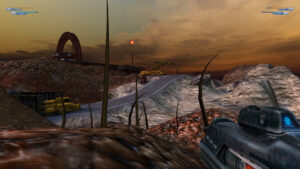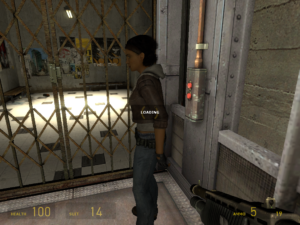A full workweek of lunchtime TF2 (and one evening session), and no post! I really have been remiss. To make up for five missed days, here’s five paragraphs on unrelated topics that summarize my week.
I’ve achieved First Milestone with the Heavy class. I had been hovering at 9 Achievements of the required 10 for a while; the one that finally put me over was for killing five enemies in a row without spinning down my minigun. See, the Heavy’s gun takes a moment to spin up before it starts firing — it’s a manifestation of the class’s slow-but-powerful theme. What’s not obvious at first is that you can keep it spinning without firing by holding down the right mouse button. While in this mode, you can start firing instantly, but at the cost of moving even more slowly than the Heavy does normally. The notable thing about this Achievement is that it’s essentially a tutorial: it draws the player’s attention to the possibility of not spinning down, and encourages one to give it a try. By the time you’ve got the Achievement, you’ve got a good handle on why, and when, keeping your gun spun up is a good idea. There are other Achievements like this, such as the Scout’s Achievement for executing 1000 double jumps, or the Spy’s Achievements for backstabbing an Engineer and sapping his buildings (in both orders), or the various ones for killing opponents with Taunt moves.
I’m getting the hang of playing as a Demoman. As with the Medic, it’s all about the secondary weapon — the stickybombs, which can be strewn about and then detonated on your signal. At work we mostly play King of the Hill maps, which makes a Demoman partcularly powerful: there’s just one important spot, and if it’s covered in your stickies, it’s very difficult for the enemy to take control of it. An enemy facing a bestickied hill basically has two options. First, they can send one guy on a suicide mission to make you detonate your bombs, then rush it with the rest of the team to capture it before you can set up them the bomb again. This involves more coordination than most ad-hoc teams are capable of. Alternately, they can just send someone to kill you before you can detonate your bombs. There are maps where there are battlements overlooking the control point that are hard to reach from the enemy’s side — ideal for Snipers, but also, I’m realizing, for Demomen, provided they can lob the stickies to where they’re needed. Even so, given the significance of the Demoman in keeping enemies off the point, and the general difficulty of killing people at close quarters with Demoman weapons, it seems like it would be a good idea for the Demoman’s teammates to station someone more melee-capable (a Pyro, say) on the route to the battlements to protect him. Either way, there’s an opportunity here for chess-like gambits involving multiple players, but ones that the gameplay (including the Achievement system) doesn’t explicitly encourage. Consequently, the opportunity is generally wasted.
I spent a little time playing the original Half-Life recently, for reasons I won’t go into, and I was struck anew by how different the feel of TF2 is. By and large, single-player FPS games live in the wake of Doom, which is to say, they’re horror games. (Even Portal, which is about as far from a typical FPS as you can get while still viewing things in first-person and using a gun, has a strong sense of nightmare.) The dominant mood in such games is the adrenaline rush. And that’s something that’s strangely missing from TF2. The cartoony style is a factor, but a relatively minor one, in my opinion. In a game without an exploration element, the sense of of anticipation is blunted, and with it any possibility of dread. Death is swift and frequent and often comes without warning, all of which also works against dread, but more importantly, death is inconsequential. I don’t mean that the only consequence is respawning back at your base — similar things could be said of conventional FPS games, where dying just means respawning at the last save point. I mean that things don’t stop happening just because you’re temporarily tagged out. If you started capturing a control point before you got killed, there’s a good chance that one of your teammates is still there finishing the job. You can even watch it happen while you wait to respawn. As a result, death doesn’t feel final, but like just one of those things that happens. That is, it doesn’t feel like death. Which probably contributes to the sense of exaggerated slapstick I described earlier.
My latest random acquisition in the game is the Sandman, a special baseball bat that the Scout can use. Its special virtue is that, unlike normal baseball bats, it can be used to hit baseballs. Baseballs that hit an opponent leave them temporarily stunned and very likely to get killed by whoever’s nearby. This is very annoying when it happens to you — as always, unexpectedly taking control away from a player creates frustration. But I have yet to actually hit anyone with a ball, as it’s a difficult skill that has to be mastered. Difficult to pull off, annoying to others wen you do — in other words, it’s kind of like playing a Spy. It strikes me that a lot of the special items have the effect of letting one class take on attributes of another. A Pyro with the Backburner becomes more lethal when attacking from behind, like the Spy. A Spy with the Ambassador can do headshots to kill instantly from a distance, like the Sniper. A Sniper with the Hunstman can be effective in melee, like most other classes.
I complained a while ago about my inability to find documentation for this game. Well, I really should have looked for a wiki earlier than I did. Blame it on my retrogaming habits — I’m not used to playing games where the wiki is an essential feature, rather than an afterthought. (Although the ancient Spoiler Files for Nethack come close.) You can call it laziness on the part of the developers, but when you come down to it, no one documents stuff as thoroughly as fans. So, given that people were probably going to make a wiki anyway, why bother with any other docs? It would have been nice if either Steam or tf2.com linked to it, but I can understand why a company, with legal obligations, would want to avoid linking to something so unaccountable. The wiki led me to the tf2.com Movies page, which I really could have noticed before, considering that there’s a link to it right on top of tf2.com, but it’s a link that, paradoxically, is too prominent to be noticeable: it’s part of the page’s banner image, which is something I generally ignore. At any rate, the Movies page is particularly significant, because that’s the one place where you can actually find a summary of the game’s premise. It shows something about the game that I’ve playing it for so long without missing that.
 Comments(2)
Comments(2)
